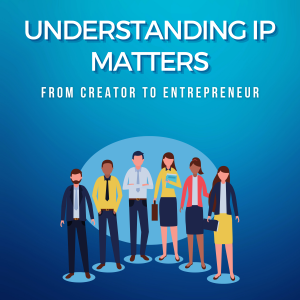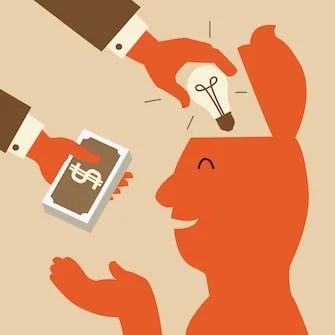The news in much of the inventing community is often doom and gloom, but for Stephen Key, a successful creator and entrepreneur, the opportunities faced by inventive people today are as varied if you approach the right product sellers in the right way. Creators who are more creative about packaging their ideas hold an edge.
Patents, he believes, especially inexpensive provisional ones, are a tool to help people share their creativity. To commercialize some products they are absolutely necessary, but to bring others to market they may not be needed — in some industries they may be an impediment.
Embracing Open Innovation: The Business of Licensing With or Without Patents is the fifth episode of the second season of ‘Understanding IP Matters’, which is available to hear now.
In an industry where inventors are regularly charged tens of thousands of dollars for help with inventions that will never make it to market, his unique perspective and commitment to giving back to the next generation of creators have earned him a large following.
Key is an award-winning inventor, entrepreneur, intellectual property strategist, and author. He is also an educator and invention coach with students in more than 65 countries. Concepts he has brought to market have retailed at Walmart, 7-Eleven, and Disney stores and theme parks worldwide. They have been endorsed by Michael Jordan, Alex Trebek, and Taylor Swift. In 1999, he co-founded inventRight, a company that teaches inventors how to design, patent, and license their ideas.

From the Stephen Key episode:
What does it take to be a successful inventor? Is there a personality type that you’ve seen? Do you see a pattern there?
“I think there is a pattern. Being curious, that’s a big part of it. Being very determined and loving it. What you realize about inventing, or being a creative person, is that it’s not so much of a job. It’s something you’re passionate about. You wake up every morning and you want do it — Saturday, Sunday, it doesn’t matter. You’re always thinking differently.
“I see that that quality in people who create things. Inventors never retire, either. I think they just keep on doing it because it’s a lot of fun to see an idea that’s in your head come to life and be used by people and solve problems.
“Individuals are hooked on it. They love it. They want to help. They’re curious. They’re determined. They recognize there are going to be a lot of obstacles and they’re not afraid of them. They ask a lot of good questions and they stay in it, because it is a tough industry. They have to have a lot of tenacity, you know. You have to be tough, have tough skin.”
What do you tell inventors — or, people who think they’re inventors — but don’t really have an invention that’s marketable. How do you convey that to them?
“I’m glad you asked that question. Most of the ideas that we see get licensed at inventRight aren’t inventions. And even if they are, they’re not called inventions. When you say ‘invention,’ you’re really talking about getting a patent issued. Right? I don’t think you need a patent issued to share your creativity and commercialize it.
“I do believe that ‘inventiveness’ is really the key word here — coming up with something new that people want and overcoming obstacles.
“Who do you think of when you say the word inventor? You think of Thomas Edison, right? Or something really big! I think that intimidates a lot of us. I would like to kind of change that a little bit to say, look, all of us can be inventive.”
Is there a future for inventors? Is it brighter than it was 20 years ago or 30 years ago?
“It’s never been a better time ever. More and more companies have embraced open innovation. They want to work with you. You have great tools such as 3D printing, so you can build those prototypes fast. You have a wonderful tool, provisional patent applications, that you can file for under a hundred dollars and get patent pending status.
“Part of what we’re trying to do at inventRight is help tear down the barriers. I think those barriers are being taught. You have to file a patent and you have to start a business and you have to do a prototype. All those things are barriers.
“What I like to say to everyone is, look, there’s something else you can learn about, which is product licensing. You don’t necessarily have to build a prototype at first; you can do a 3D computer generated model to see if there’s interest. You can file a provisional patent application. You can find a company that’s got the shelf space, so you don’t have to start a company yourself. What that does is allows everyone to participate.
“Yes, I think it’s never been such an amazing time to jump in if you’re creative.”
Listen to the entire episode here to learn more about Key’s perspective on open innovation and licensing, including:
- How he got started as an entrepreneur
- His most financially successful idea
- Why it’s possible to license an idea without an issued patent today
- Why companies that embrace open innovation are not in the habit of ripping off inventors
- How to make a patent application valuable from a business perspective

For more information about Key and inventRight, visit https://inventright.com/
‘Understanding IP Matters’, now in its second season, explores the IP story of people who have succeeded in the world of inventions, creative expression, and brands— those with the scars and spoils to prove it.
It is the first podcast series to convey the journey from creator to entrepreneur of high-performing inventors and creators in their own words.
UIPM is brought to you by the Center for Intellectual Property Understanding, an independent non-profit and its subscribers. CIPU provides outreach within an educational framework to improve IP literacy and promote sharing.
To peruse S1 and S2 episodes, go here, or wherever you listen to your podcasts, including Apple, Google, Buzzsprout and Spotify.
Image source: ipwacthdog.com; CIPU; understandingip.org

